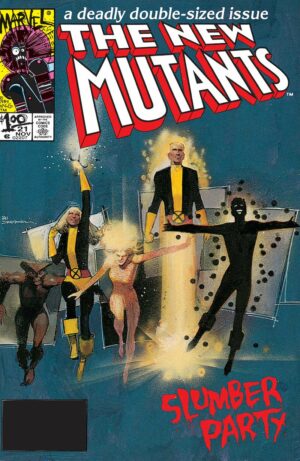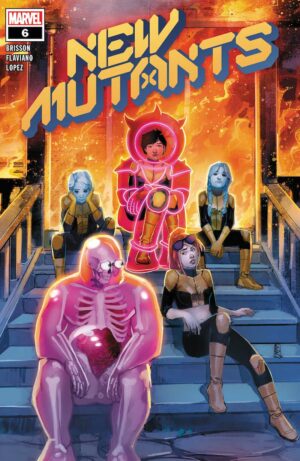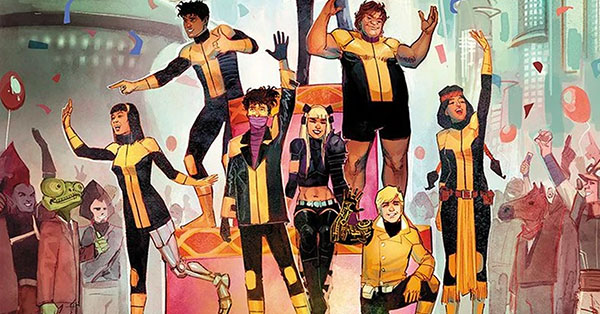I’m excited to share this massive guide rebuild with you because it transformed a page that has been a “catch-all” guide for the past decade into a coherent and well-organized guide to every new generation of X-Men characters from their Giant-Size “Second Genesis” to the present day. Welcome to my all-new, all-different New Mutants Guide – covering New Mutants, Generation X, Academy X, Generation Hope, & other young X-Men titles.
Guide to New Mutants & Young X-Men
This New Mutants Guide now covers every “class” of new mutants, starting with the aptly named New Mutants in 1983 through the present day. If it’s a title focused on a new generation of mutants in the present day (or, in one case, an old generation), it’s covered in this guide.
What do those classes include? After much consideration, I’ve broken up them up as follows:
1st Class: The original Silver Age X-Men, plus Havok and Polaris. (Also Mimic, if you insist.)
2nd Class: The Giant-Size “Second Genesis” team, who Xavier quickly realizes he cannot treat as students. (Well, at least not Wolverine).
3rd Class: New Mutants, including Magma, Warlock, Doug, and their later additions from X-Factor, Fallen Angels and X-Terminators through their transformation into X-Force. (Technically, Kitty, Rachel, Psylocke, and even Longshot could be grouped into this class, but they all were promoted the main squad.)
4th Class: Generation X, including Jubilee although she debuted much earlier.
5th Class: Academy X, including their transformation into Young X-Men. Many are still students in the present day.
6th Class: Generation Hope & The Jean Grey School. Effectively, any mutant new enough to enroll in the Jean Grey School is, by definition, part of Generation Hope since it was Hope who reignited the emergence of mutant powers around the globe. I’d include all characters who debuted as students through 2019 in this category through late adds like Nature Girl.
1st Class Returns: All-New X-Men, from when they were snatched from Uncanny X-Men (1963) #8 through their return to the past in Extermination. (Their adventures sometimes included 5th & 6th Class members.)
7th Class: Age of Krakoa, including all young mutants who have debuted since House of X and Powers of X.
Each of these classes all have obvious starting points, major stories, and some form of graduation to define them. I’m sure we could get into a lengthy fan debate about different sub-classes within New Mutants, or if we should really say that the 6th Class lasts that long, or to which class Scout truly belongs.
Those distinctions would only complicate a guide to these titles. In this newly renovated New Mutants Guide, every young mutant title is accompanied by a “class” tag to indicate which classes are active in it. For example, New Mutants (2003) includes the 3rd Class, but they’re also assembling the 5th Class in that title. And, Wolverine & The X-Men (2011) was the home of the 6th class, but many 5th class students continued into that run.
As with many of my recent guide updates, reorganizing this guide in a coherent way for modern readers meant rebuilding it from scratch. As I did that, I had the chance to reflect on why my 2010s guides now require so much re-building – which is actually making them much simpler.
When I first made a New Mutants guide in 2010, the options for collecting the 1983 title were limited to three distinct categories.
We had Classic collections to reach the end of Claremont’s run at issue #54, and then various collections of the Liefeld/Cable period starting from #87. If you wanted any of the Louise Simonson run between the two, you could find much of it (but not all of it) in the X-Men Oversize Hardcover line beginning with Fall of the Mutants.
Every so often, some other collection might include a New Mutants issue – like Acts of Vengeance or the modern New Mutants Forever. These tiny slices of coverage were gold for those of us trying to build a complete New Mutants bookshelf. They were the whole point of having a guide.
That made for a guide that was built around many small slices of issues, along with many wide gaps. That wasn’t just true for New Mutants. That’s how every guide to a classic title worked for the first five years of Crushing Comics. Similarly, “trade era” titles from after 2004 were about a long list of single arc trade paperbacks – sometimes with an accompanying hardcover release.
Starting in 2014, Marvel radically altered their collection strategy. There’s the obvious addition of their comprehensive Epic Collections, and also a willingness to issue Complete Collections to repackage modern runs and “Milestones” trades for X-Men events. (Complete Collections have now been rebranded to “Modern Epics,” because Marvel loves to figure out how to get you to buy something twice.)
The second addition was the subtle progression of Marvel’s expansion of the Omnibus program. Omnibuses used to collect only the major events and biggest runs and were very often released in conjunction with multi-media properties like shows and movies. Now, Marvel has realized (thanks to folks like Omar @ Near Mint Condition) that they have an audience of bookshelf collectors who want complete, unbroken bookshelves.
And, crossing both of those changes, Marvel now reprints their books! A decade ago that was something they did only for the rare popular omnibuses like Uncanny X-Men, Amazing Spider-Man, or New X-Men.
These changes to Marvel’s collection strategy are a major driver of my push to completely reorganize my oldest guides. A laundry list of collected issue ranges no longer make any sense for a title like New Mutants (1983). No one is going hunting for one random issue collected in another trade! Now, the title is better addressed by separately grouping oversize hardcovers, Epics, older collections like Classics.
In some ways that simplifies guide-making, but in others it makes it more complex. You’d think making a list of those broad collection formats would be easy going! Yet, even that can be complicated as they accumulate reprints and require explainers for the line-wide events they briefly visit.
I think the change also leaves room for more detail on guest appearances that fall outside of those Epic Collections. Some lines do better than others in collecting every major appearance associated with as single character or title. That’s easy to do for a character who was relatively self-contained in the 80s and 90s, like Hulk, but harder for Captain America, Wolverine, or an increasingly-ubiquitous team like X-Men.
I think there’s still more to do in a next revision of this Guide to New Mutants & Young X-Men to continue to explain these generations of new mutants and define where they come from and where they’re going. However, at this moment I’m incredibly satisfied with what this guide has become nearly 13 years after I first started compiling it.
This continues my weekly series of updates to my core of X-Men guides to ensure their reading order is complete and they list every collected edition through the present day. Don’t worry, I haven’t forgotten about the rest of my 100s of other guides to the Marvel Universe – or the DC Universe, either! If there’s a non-X guide that is your top pick for an update, let me know in the comments below! Readers who voice their opinions have a major sway over my choices.
